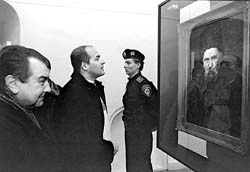Curing with a Provocation

The new exhibition opened at Kyiv’s Center of Modern Art was marked by mass interest from the media and unprecedented public attention. The organizers succeed in imbuing the event with the foretaste of sensation and provoking a stir around it. Practically all the major newspapers and television channels, prominent politicians, not to mention art critics of all kinds, came to see the Ukrainian Trademark exhibition.
The exposition’s structuring idea is in a way cultural re-export of talents. Works by artists of Ukrainian origin are collected at the center. Oleh Kulyk, for example, presented his photo collages series already demonstrated in Moscow, depicting a couple of Homo sapiens copulating against a background of stuffed birds and animals, which look more vivid and real than the people. The struggle for animals’ rights constantly proclaimed by Kulyk is gaining a form closer to the style of glossy magazines.
A new video by Alexander Roytburd, former Odesa resident now living in the USA, was demonstrated in a separate hall. This black and white video is a cutting from Dziga Vertov’s films, pornographic films, and shots in an anatomical theater. Roytburd chose a game he could not lose, since Vertov’s images cannot be marred.
Among other works Taras Polataiko’s performance is worth mention: a red oval with a slit painted on it, a remake of Lucio Fontana’s work, hanging on the wall and an old lady sitting across it painstakingly embroidering the same painting on a special machine. Artist Tibery Silvashy appears in somewhat unusual co-authorship with photographer Ihor Haiduk. Their 3D collage meets the public at the entrance to the exhibition. Kyivan Illia Chichkan understood the name, Trademark, literally and exhibited perfume of his own production accompanied with a presentation according to all the commercial canons.
Undoubtedly, the action’s central element, which aroused the whole stir around it, was a Taras Shevchenko portrait attributed by the organizers and the Masoch Foundation (including Ihor Diurych and Ihor Podolchak) to David Burliuk. The ritual of presenting a rarity was carefully observed. The spectators approached the portrait along a strip of carpet; the painting itself was placed on a separate glazed stand flanked by two stone faced guards wearing a militia Titan Regiment uniform. The painting’s mysterious detective story was expounded by Kyiv media more than once. Shevchenko was believed to be lost, went through ordeals of all kinds, and finally was bought for a decent sum at Sotheby’s by a well-off collector from the diaspora who kindly granted it for exhibition in Kyiv. Sotheby’s official web site lists the Taras Shevchenko portrait among its lots sold. It is an authentic Burliuk depicting Kobzar in a sound realistic manner.
However, even if all this were a hoax, its authors still would deserve a standing ovation. To create a powerful artifact with its own history, mythology, and its own special political and artistic atmosphere would take a very talented provocateur.
Paradoxical as it is, the provocation was a success. The Ukrainian essence of the works on display really became a popular trademark. In a word, a few days achieved what the Ukrainian government could not accomplish in ten years with its calls to buy Ukrainian.






